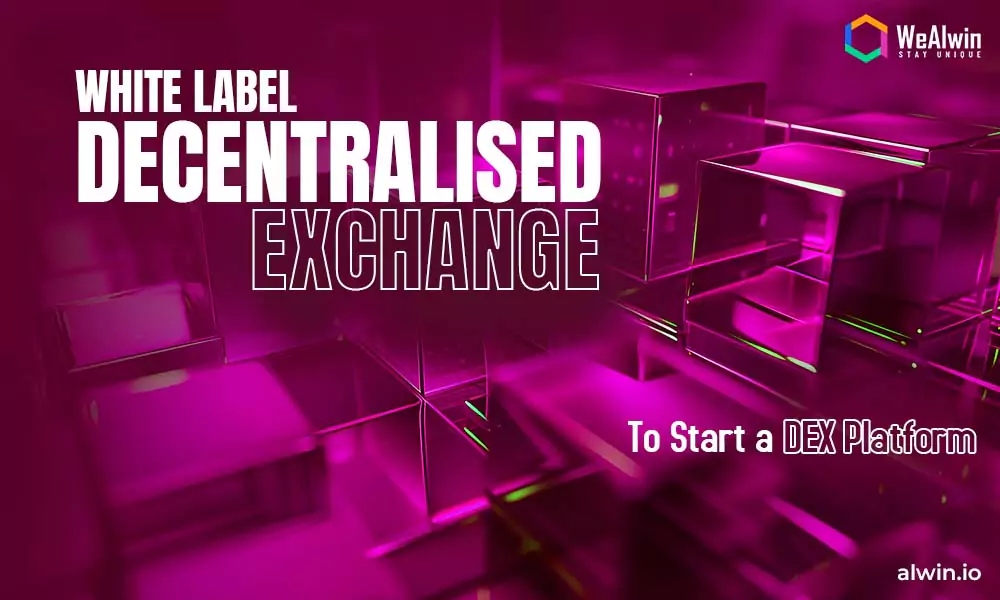Decentralized exchanges (DEXs) have revolutionized the way we trade cryptocurrencies, offering a secure, transparent, and trustless environment for peer-to-peer transactions. Unlike centralized exchanges, DEXs eliminate the need for intermediaries, reducing the risk of hacks and fraud. This shift towards decentralization aligns with the core principles of blockchain technology: transparency, security, and user empowerment. As a result, DEXs are becoming increasingly popular among crypto enthusiasts and traders who value privacy and control over their assets.
What is a White Label Decentralized Exchange?
White Label Decentralized Exchange (DEX) is a pre-built, customizable decentralized exchange software solution that allows businesses to launch their own decentralized exchange platform. This ready-made infrastructure includes all the essential features and functionalities required for a DEX, such as automated market making, liquidity pools, order matching, and secure transaction processing. By utilizing a white-label DEX, businesses can significantly reduce the time and resources needed to develop a DEX from scratch, enabling a faster go-to-market strategy.
White-label DEX solutions are designed to be flexible and adaptable, allowing businesses to tailor the platform to their specific needs and branding. This means that the user interface, trading pairs, fee structures, and other components can be customized to align with the business's vision and target audience. The core advantage of a white-label DEX is that it leverages proven technology and infrastructure, ensuring reliability and security while allowing for rapid deployment and scalability.
Rise of White-Label Decentralized in Blockchain
As the demand for DEXs grows, so does the interest in white-label solutions. A white-label DEX is a pre-built platform that can be customized and branded by businesses to launch their own decentralized exchange quickly and cost-effectively. These solutions offer a range of features and functionalities that cater to the specific needs of different markets and user bases. By leveraging white-label decentralized exchange, businesses can enter the market faster, reduce development costs, and focus on scaling their operations and enhancing user experience. The rise of white-label solutions is a testament to the maturation of the blockchain industry, providing entrepreneurs with the tools they need to innovate and succeed.
Difference Between White-Label and Custom-Built Solutions
While both white-label and custom-built solutions aim to create a functional DEX platform, they differ significantly in terms of development process, cost, and time-to-market.
Development Process:
Custom-built solutions are developed from the ground up, requiring significant time and effort in planning, coding, testing, and deployment. This approach allows for complete control over every aspect of the platform but demands extensive technical expertise and resources. In contrast, white-label solutions provide a ready-made framework that can be customized, drastically reducing the complexity and duration of the development process.
Cost:
Developing a custom-built DEX involves substantial financial investment in hiring skilled developers, conducting rigorous testing, and maintaining the platform post-launch. This can be prohibitive for many startups and smaller businesses. On the other hand, white-label solutions offer a more cost-effective alternative by providing a pre-built infrastructure at a fraction of the cost of developing a custom solution. The pricing model for white-label solutions typically includes a one-time licensing fee and ongoing support costs.
Time-to-Market:
Speed is a critical factor in the rapidly evolving blockchain space. Custom-built DEXs require extensive development time, often taking months or even years to complete. This delay can result in missed market opportunities and increased competition. White-label solutions enable businesses to launch their DEX platforms quickly, often within weeks, allowing them to capitalize on current market trends and gain a competitive edge.
Flexibility and Customization:
While custom-built solutions offer unparalleled flexibility, allowing businesses to implement unique features and designs, white-label DEXs also provide a high degree of customization. Businesses can modify the user interface, select specific trading pairs, configure transaction fees, and incorporate additional functionalities as needed. However, certain aspects might be limited by the underlying architecture of the white-label solution.
Key Features of White Label DEX Software
Customizability
White-label decentralized exchanges offer extensive customization options, allowing businesses to tailor the platform to their specific needs and branding. This includes the ability to customize the user interface, select and add trading pairs, set transaction fees, and integrate additional features such as staking, lending, or advanced trading tools. Customizability ensures that the platform aligns with the business's unique vision and target audience, providing a personalized experience for users.
Security Features
Security is paramount in any trading platform, and white-label DEXs come equipped with robust security measures. These include:
Decentralized architecture: Eliminates a single point of failure, reducing the risk of hacks.
Smart contract security: Regular audits and updates to smart contracts to prevent vulnerabilities.
Multi-signature wallets: Ensures that multiple keys are required for transactions, enhancing security.
DDoS protection: Safeguards against distributed denial-of-service attacks.
Encryption: Protects user data and transaction information.
Scalability
Scalability is a crucial feature for any growing platform. White-label DEX solutions are designed to handle increasing user numbers and transaction volumes efficiently. They employ scalable infrastructure and technologies that can accommodate growth without compromising performance. This includes the ability to integrate with multiple blockchain networks, support high transaction throughput, and ensure low latency.
User Interface and Experience
A user-friendly interface is vital for attracting and retaining users. White-label DEXs provide customizable and intuitive UI/UX designs that cater to both novice and experienced traders. Features such as responsive design, easy navigation, real-time data analytics, and advanced charting tools contribute to a seamless trading experience. Additionally, multi-language support and accessibility features can be integrated to broaden the platform's reach.
Technical Support and Updates
Reliable technical support and regular updates are essential for maintaining a high-performing DEX platform. White-label solutions offer ongoing technical support to address any issues that arise, ensuring minimal downtime and optimal functionality. Regular updates are also provided to enhance features, improve security, and adapt to market changes. This continuous support helps businesses keep their platforms competitive and secure.
Benefits of Using White Label Decentralized Exchange for Launching a DEX
Cost-effectiveness
Launching a DEX using a white-label solution is significantly more cost-effective compared to building a platform from scratch. Businesses can save on development costs, as the core infrastructure and essential features are already developed and tested. This financial efficiency allows for the allocation of resources towards marketing, user acquisition, and other growth strategies.
Faster Time-to-Market
White-label DEX solutions enable businesses to launch their platforms much faster than custom-built solutions. The pre-built infrastructure and ready-to-deploy features shorten the development timeline from months or years to weeks. This rapid deployment is crucial in the fast-paced blockchain industry, allowing businesses to quickly capitalize on market opportunities and stay ahead of the competition.
Reduced Development Effort
By utilizing a white-label solution, businesses can significantly reduce the complexity and effort involved in developing a DEX. The technical heavy lifting is handled by the white-label provider, freeing up the business to focus on customization, branding, and strategic planning. This reduction in development effort simplifies the process and minimizes the risk of technical challenges and delays.
Proven Technology and Infrastructure
White-label DEX solutions are built on proven technology and infrastructure that have been tested and refined. This reliability ensures that the platform operates smoothly, securely, and efficiently. Businesses can leverage this established technology to provide a stable and trustworthy trading environment for their users, fostering confidence and trust.
Focus on Business Growth Rather Than Technical Complexities
With the technical aspects of the DEX handled by the white-label provider, businesses can concentrate on growth and expansion. This includes developing marketing strategies, building partnerships, engaging with the community, and enhancing the user experience. By focusing on these critical areas, businesses can drive adoption, increase trading volumes, and achieve long-term success.
How to Launch a DEX Using White Label Decentralized Exchange?
Step 1: Define Your Business Objectives
Identifying Target Audience and Market Needs Start by identifying your target audience and understanding their needs and preferences. Conduct market research to analyze competitors, identify gaps in the market, and determine the unique selling points of your DEX. Understanding your audience will help you tailor your platform’s features and marketing strategies effectively.
Setting Goals and KPIs Define clear business objectives and set key performance indicators (KPIs) to measure your success. Goals might include user acquisition targets, trading volume milestones, or revenue projections. KPIs could include metrics like the number of active users, transaction fees collected, or customer satisfaction scores. These goals and KPIs will guide your strategic planning and help you monitor progress.
Step 2: Choose a White-Label DEX Provider
Criteria for Selection Choose a white-label DEX provider based on several key criteria:
Reputation and Experience: Look for providers with a proven track record and positive customer reviews.
Customization Options: Ensure the provider offers extensive customization to meet your specific requirements.
Security: Verify that the provider implements robust security measures, including smart contract audits and data encryption.
Support and Maintenance: Evaluate the quality and availability of technical support and regular updates.
Cost: Consider the pricing structure and ensure it aligns with your budget.
Step 3: Customize Your Platform
Branding and Design Customize the user interface and design elements to reflect your brand identity. This includes your logo, color scheme, and overall aesthetic. A visually appealing and cohesive design enhances user experience and helps establish your brand in the market.
Feature Selection and Integration Select and integrate the features that are most relevant to your target audience. This could include advanced trading tools, staking and lending options, multi-currency support, and more. Ensure that the platform is user-friendly and intuitive, catering to both novice and experienced traders.
Step 4: Ensure Compliance
Understanding Regulatory Requirements Research and understand the regulatory requirements in the jurisdictions where you plan to operate. This includes licensing, data protection laws, and financial regulations. Compliance is crucial to avoid legal issues and build trust with users.
Implementing KYC/AML Procedures Implement Know Your Customer (KYC) and Anti-Money Laundering (AML) procedures to comply with regulatory standards. This involves verifying user identities and monitoring transactions for suspicious activities. Effective KYC/AML measures protect your platform from fraud and enhance its credibility.
Step 5: Integrate Payment Solutions
Fiat Gateways Integrate fiat gateways to enable users to deposit and withdraw fiat currencies. This requires partnerships with payment processors or banks that can facilitate fiat transactions. Offering fiat integration broadens your platform’s appeal to a wider audience.
Cryptocurrency Payment Processors Implement cryptocurrency payment processors to handle crypto transactions. Ensure that the processors support a wide range of cryptocurrencies and offer low transaction fees. Reliable payment solutions enhance the trading experience and ensure smooth transactions.
Step 6: Test the Platform
Functional Testing Conduct thorough functional testing to ensure that all features and functionalities work as intended. This includes testing the trading engine, user interface, payment gateways, and other critical components.
Security Auditing Perform comprehensive security audits to identify and fix vulnerabilities. This includes smart contract audits, penetration testing, and security reviews. Robust security measures are essential to protect user funds and data.
User Acceptance Testing Conduct user acceptance testing (UAT) with a group of beta users to gather feedback and identify any usability issues. UAT helps ensure that the platform meets user expectations and provides a smooth trading experience.
Step 7: Prepare for Launch
Marketing and Promotional Strategies Develop and execute marketing strategies to generate buzz and attract users to your platform. This could include digital marketing campaigns, social media promotions, influencer partnerships, and press releases. Effective marketing ensures a successful launch and drives user acquisition.
Community Engagement and Support Engage with the community to build a loyal user base. This includes active participation in forums, social media interactions, and hosting events or webinars. Providing excellent customer support and addressing user queries promptly fosters trust and loyalty.
Step 8: Launch Your Exchange
Soft Launch vs. Full Launch Consider starting with a soft launch to a limited audience to identify and fix any issues before a full-scale launch. A soft launch allows you to gather feedback and make necessary adjustments. Once confident, proceed with the full launch, opening the platform to a broader audience.
Monitoring Initial Performance Monitor the platform’s performance closely during the initial phase. Track key metrics such as user registrations, trading volumes, and system stability. Address any issues promptly to ensure a smooth user experience.
Step 9: Post-Launch Support and Maintenance
Continuous Improvement Continuously improve the platform based on user feedback and market trends. Regularly update features, enhance security, and introduce new functionalities to keep the platform competitive.
Customer Support Provide robust customer support to assist users with any issues or queries. Offering multiple support channels, such as live chat, email, and phone support, ensures that users receive timely assistance.
Ongoing Security Updates Regularly update security measures to protect the platform from emerging threats. Conduct periodic security audits and implement the latest security protocols to safeguard user assets and data.
How Much Does a White-label Decentralized Exchange Cost?
Breakdown of Costs
The cost of launching a white-label decentralized exchange (DEX) can vary widely based on several factors. Here’s a general breakdown of potential costs:
Licensing Fee: This is the initial cost paid to the white-label DEX provider for using their platform. It typically ranges from $10,000 to $50,000, depending on the provider and the package chosen.
Customization Costs: Customizing the platform to align with your branding and feature requirements can incur additional costs. This includes UI/UX design, adding new functionalities, and integrating specific features. Customization costs can range from $5,000 to $30,000.
Integration Costs: Integrating payment gateways, KYC/AML solutions, and other third-party services may involve additional expenses. These costs can range from $5,000 to $20,000.
Security Audits: Conducting comprehensive security audits to ensure the platform's safety can cost between $10,000 and $30,000. Regular security updates and maintenance should also be considered.
Legal and Compliance Fees: Ensuring compliance with regulatory requirements involves legal consultation and possibly obtaining licenses. These costs can vary widely based on the jurisdictions you plan to operate in but typically range from $5,000 to $20,000.
Hosting and Infrastructure: Ongoing costs for hosting the platform and maintaining the underlying infrastructure. These can be monthly or yearly expenses, generally ranging from $1,000 to $5,000 per month.
Marketing and Promotion: Initial and ongoing marketing efforts to attract users to your platform. Marketing budgets can vary significantly but expect to allocate at least $5,000 to $20,000 for initial campaigns.
Support and Maintenance: Ongoing technical support and platform maintenance costs, which can be monthly or yearly. These usually range from $1,000 to $5,000 per month.
Factors Affecting the Cost
Several factors can influence the overall cost of launching a white-label DEX:
Provider Choice: Different white-label DEX providers offer varying pricing models based on their reputation, features, and support levels.
Customization Level: The more customization required, the higher the cost. This includes custom features, design elements, and unique functionalities.
Regulatory Environment: Operating in multiple or highly regulated jurisdictions can increase compliance costs.
Security Requirements: Enhanced security measures, such as multiple audits and advanced protection features, add to the cost.
Integration Needs: The number and complexity of third-party integrations (e.g., payment gateways, KYC/AML services) can significantly impact costs.
Scale and Scope: The scale of the platform (e.g., expected user base, transaction volume) affects infrastructure and maintenance costs.
Estimated Time to Launch a DEX Using White-label Decentralized Exchange
Typical Timeline
The time required to launch a white-label DEX varies based on the level of customization and the readiness of the platform. Here’s a typical timeline:
Initial Setup and Planning (2-4 weeks)
Define business objectives
Select a white-label DEX provider
Outline customization and integration requirements
Customization and Development (4-8 weeks)
Customize the platform’s design and features
Integrate payment solutions and other third-party services
Implement security measures and conduct initial testing
Compliance and Legal Setup (2-6 weeks)
Ensure regulatory compliance
Implement KYC/AML procedures
Obtain necessary licenses
Testing Phase (2-4 weeks)
Conduct functional testing
Perform security audits
Conduct user acceptance testing (UAT)
Marketing and Pre-launch Preparation (2-4 weeks)
Develop marketing strategies and promotional content
Engage with the community and build anticipation
Prepare support channels and customer service infrastructure
Launch (1-2 weeks)
Conduct a soft launch to a limited audience
Monitor performance and address initial issues
Proceed with full launch
Post-launch support and Continuous Improvement (Ongoing)
Provide ongoing customer support
Implement regular updates and improvements
Monitor performance and security continuously
Milestones and Phases
Milestone 1: Business Planning and Provider Selection
Define objectives, target audience, and KPIs
Select a white-label DEX provider
Milestone 2: Platform Customization and Integration
Customize design and features
Integrate payment solutions, KYC/AML procedures, and other services
Milestone 3: Compliance and Legal Setup
Ensure platform complies with relevant regulations
Implement necessary legal structures
Milestone 4: Testing and Quality Assurance
Complete functional and security testing
Conduct UAT to ensure readiness
Milestone 5: Marketing and Community Engagement
Launch marketing campaigns
Build and engage with the community
Milestone 6: Soft Launch and Full Launch
Conduct a soft launch
Monitor and optimize platform performance
Execute full launch
Milestone 7: Ongoing Support and Improvements
Provide continuous customer support
Implement regular updates and improvements
Conclusion
Launching a white-label decentralized exchange (DEX) offers a streamlined and cost-effective approach to entering the rapidly growing cryptocurrency trading market. By leveraging a pre-built, customizable platform, businesses can enjoy a range of benefits while minimizing the complexity and costs associated with developing a DEX from scratch.
This enhanced outline should provide a comprehensive guide for readers interested in launching their own DEX using a white-label solution.
If you’re ready to take the next step, start by defining your business objectives and reach wealwin technologies as a top decentralized exchange development company to engage with industry experts and assess your customization needs, and begin the process of platform selection and development. The path to launching a successful DEX is well within reach, and with the right preparation and execution, your platform can become a significant player in the crypto trading space.
Seize this opportunity to innovate and contribute to the evolving landscape of decentralized finance. Your future DEX awaits!



